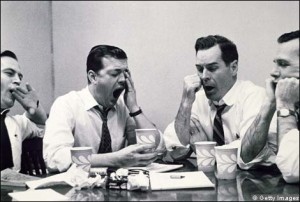YAWNING
VII. Oxytocin (OT, OxT, Oxy)
A. Nonapeptide synthesized by the PVN and SON of the hypothalamus
1. NH2 - Cys - Tyr- Ile - Gln - Asn - Cys - Pro - Leu - Gly - COOH
|_____S_____S_______|
a. cysteine-cysteine disulfide bonds
b. Evolutionary precursor = Arginine Vasotocin (AVT)
i. NH2-Cys - Tyr- Ile - Gln - Asn - Cys - Pro - Arg - Gly-COOH
|_____S_____S_______|
2. PVN magnocellular subnucleus makes mostly OT
a. supraoptic magnocellular subnucleus mostly AVP
b. pro-OT produced from OXT gene
includes neurophysin I (carrier protein)
i. cleaved in golgi by
peptidylglycine a-amidating monooxygenase (PAM)
c. OT transported into dendrites
i. retrograde dendritic release is critical
to control OT neuron firing patterns (inhibits Glu)
3. OT also synthesized by smaller, parvocellular neurons
of the PVN and medial preoptic area (mPOA)
4. OT synthesized by neurons in the BNST and LA
(bed nucleus of the stria terminalis) and (lateral amygdala)
a. OT fibers project into the brain
B. OT Receptors
1. genterated in terminal regions from the OXTR gene
a. OXTR polymorphism (rs53576) occurs in the 3rd intron
i. 3 types: GG, AG, AA
ii. A-allele carrier Þñstress sensitivity
ò social skill / mental health
2. OT-R is a rhodopsin-type (class I) receptor
a. functionally homologous to V1 receptors
ö DG Þ PKC
b. GpÞPLC ÞPIP2 ÞIP3 ÞCa++
C. OT terminals and OT-R are widely distributed throughout the brain & spinal cord
1. Limbic brain: olfactory bulb (OB), tubercle and anterior olfactory nucleus
neocortex, and lateral septum
ventromedial hypothalamus (VMH)and preoptic area (POA)
a. Extended Amygdala & Striatum: LA, CeA, and BNST
ventral tegmental areas (VTA), nucleus accumbens (NAc)
b. Hippocampal formation: hippocampus, subiculum
endopiriform cortex
i. act as neurotransmitter or neuromodulator
2. medio-dorsal region of the nucleus of the solitary tract
a. regulate autonomic nervous system (PVN Þ NST)
3. OT terminals on neurohemal organ
a. secreted by neurohypophysis into capillary of
inferior hypophysial vasculature
D. Hormonal Physiology of OT
1. Milk Ejection Reflex, Uterine contraction/Parturition, Orgasm
a. neuroendocrine reflexes
i. sensory stimulation Þafferent signalÞñ PVN Þñ OT release Þ bloodstream
ii. sensory feedback from nipple / cervix / genetalia
b. OT-R found in the smooth muscle of the
mammary, uterus, vas deferens, and vestibular gland ducts
i. OT-R ®ñ GpÞPLC ÞIP3 ÞñCa++/Calmodulin
ii. Ca++ release is central to all muscle contraction
including smooth muscle
c. contraction of smooth muscle
i. oxy-tocin (wknx tokocx) Greek for "swift birth"
E. OT stimulates Behavioral Functions
1. Combined result of neuronal, CSF, and humoral OT
a. neuromodulatory and hormonal effects are synergistic
2. Fear
a. OT Þñ inhibitory amygdalar circuit Þò fear responses
b. Nasally administered OT Þò fear in humans
i. OT Þñ recognition of fear
ii. OT Þò anxiety
3. Learning and Memory
i. OT Þò memory retrieval of aversive memory
ii. OT Þñ social learning and memory
1) intranasal OT Þñ memory for human faces
a) especially happy faces
2) intranasal OT Þñ recognition for positive social cues
4. Trust
a. positive social interactions Þñ OT release
b. OT Þñ contentment, feelings of calmness and security
c. OT Þñ trust in humans
i. OT Þò fear of social betrayal
ii. intranasal OT Þ share ñ emotional details & significance
iii. intranasal OT Þ find faces more trustworthy
iv. intranasal OT Þñ generosity
v. ñ trust induced by OT is limited in degree
1) intranasal OT also Þñ envy and Schadenfreude
vi. intranasal OT Þñ empathy
1) MDMA (ecstasy) may Þñ 5-HT1A Þñ OT activity
Þñ feelings of empathy, love, and connection to others
d. Autism
i. autism is correlated with genomic deletion of OXTR
1) autism Þ aberrant methylation of OXTR
ii. patients inhaled OT Þñ appropriate social behavior
1) intranasal OT Þñ emotion recognition
2) OT treatment Þñ interpretation of emotions
3) OT Þñ retention of affective speech
iii. OT treatment Þò repetitive behaviors
5. Pair Bonding and Parental Behaviors
i. Brain OT released during sexual activity is important
for forming monogamous pair bonds
1) similar for females and males
ii. intranasal OT Þ men in monogamous relationships Þñ distance
between themselves and attractive women
1) not single men
iii. non-pair bonding
1) humans and dog [OT] rise minutes after petting
iv. OT important for initiation of parental behavior
1) not maintenance
2) OT antagonists after birth Þò maternal behavior
3) Þñ CSF OT Þñ maternal behavior in virgin ewes
6. Sexual and Reproductive
a. OT affects social distance between adult males and females
i. influences romantic attraction
b. OT has important role in Þñ sexual arousal
i. [OT] increases throughout sexual arousal
ii. OT Þñ lordosis and sexual receptivity
iii. ñ CSF OT Þñ spontaneous penile erection
1) OT-R antagonist blocks non-contact erections
c. OT may Þñ inhibition of the brain regions associated
with behavioral control, fear, and anxiety
allowing orgasm to occur
d. OT released at orgasm Þñ gentital smooth muscle contraction
7. improved Wound healing
a. OT Þò certain [cytokine] Þò inflamation
b. ñ OT release Þ faster wound healing
i. + social interactions Þñ OT release Þñ healing
8. Stress
a. OT protects against stress
i. OT Þò stress with a good efficiency
1) OT Þ alleviate mood
b. Inhibition of HPA axis
i. OT indirectly inhibits release of ACTH
1) functional antagonist of AVP?
ii. OT indirectly ihibits release of F (cortisol)
c. Stress causes relapse, but OT Þò development of drug tolerance
1) OT reduces withdrawal symptoms
9. OT Þñ autonomic sympathetic activity
a. parvocellular PVN OT directly connects to NST neurons
i. NE and Epi regulates OT-NST synapse number
ii. OT-R also found in T1-T4 spinal cord
b. sympathetic outflow is regulated through a combination
of PVN glutamate, OT, AVP and CRF
VIII. ACTH & aMSH
